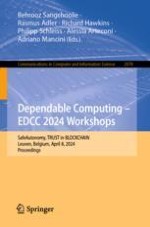This book constitutes the refereed proceedings of Workshops held at the 19th European Dependable Computing Conference, EDCC 2024: First Workshop on Safe Autonomous Systems, SafeAutonomy 2024, and the First Workshop on the Role of TRUST in the implementation of Digital Technologies: Blockchain Technology and Artificial Intelligence in Smart Cities, TRUST IN BLOCKCHAIN 2024.
The 13 workshop papers presented in this book were thoroughly reviewed and selected from 14 submissions. The TRUST IN BLOCKCHAIN workshop accepted extended abstract submissions, whereas the SafeAutonomy workshop accepted regular technical papers, case studies, PhD forum papers, as well as position papers. They deal with latest research results on theory, techniques, systems, and tools for the design, validation, operationand evaluation of dependable and secure computing systems.
